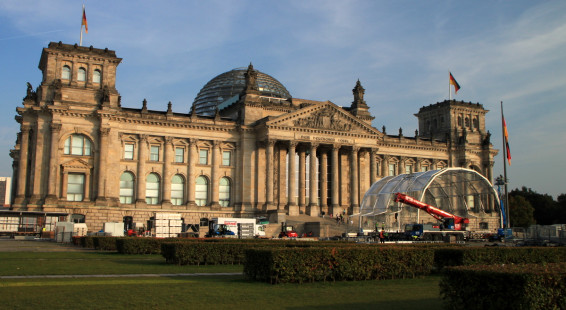
A Brief History of the Reichstag
When Germany first unified in the late 19th century, the need for a parliament building was apparent and a competition for the best design was held. The winning entry for the Reichstag building was from Paul Wallot (there were 183 entries), and his beautifully designed building was completed in 1894. It featured a neo-renaissance style with a grand classic entrance including columns and a broad staircase. There was a crown atop of the building’s steel dome. The famous inscription, ‘Dem Deutschen Volke’ (To the German People), was added in 1916 by Emperor William II.
The building was severely damaged by a fire in 1933, seen as an opportunity Hitler who used the incident to blame the Communists and to built up his power base. The building was damaged even more in the second World War, especially during the Soviet siege of the city. The Russian soldiers left a lot of graffiti at the Bundestag when they gained control of it (the graffiti has been preserved in many interior areas as the Germans consider it part of their history). After the war, the Reichstag was in the Western part of the city, very near the Berlin Wall. Its original dome was demolished but the building was partially repaired in the 1950s and 1960s.

Reichstag dome at night
After reunification in 1990s, and with the Bundestag’s move from Bonn back to Berlin, it was clear the old Reichstag was in need of extensive modernization. British architect, Sir Norman Foster, was commissioned to carry out the huge project and did so in spectacular fashion. The outside of the building was repaired but not updated. The inside of the building was extensively reconstructed, including a complete modernization of the plenary chamber. It is really pretty amazing, with a massive German eagle standing proud behind the gathering.

Gigantic Eagle at the back of the Parliamentary Chamber
The design of the roof was a little controversial, with the Bundestag voting for the updated modern dome you see today. This new cupola contains a large central glass cylinder that is designed to reflect natural light into the plenary chamber with its system of mirrors. The Cupola also provides natural ventilation.
The Bundestag formally moved back into the Reichstag in 1999.
Visiting the Reichstag
The Reichstag is a popular tourist destination. Visitors can take guided tours of the Bundestag (free), which are quite interesting. You spend the better part of an hour being taken around the complex, including modern elements.
Your tour ends in an elevator ride to the top of the building. Separate visits of just the top of the building are also an option. From the roof you can explore the viewing terrace with great views of the city. You can also visit the dome and walk up its ramp for changing perspectives and views of the city. Reservations are a must and should be made well in advance for you to receive the time slot of interest to you.
We visited the Reichstag in the evening, and enjoyed the city lights and glass dome all lite up. But I’d recommend a daytime visit when you can properly see the many features of Berlin and its Tiergarten. But the price is right and it’s a wonderful building to see and from which to learn some of Germany’s history. Highly recommended.
(Click on thumbnails to enlarge, then right arrow to advance slideshow)